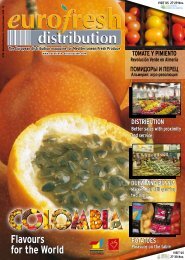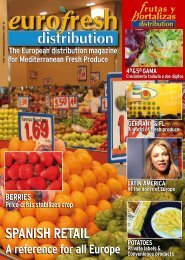Create successful ePaper yourself
Turn your PDF publications into a flip-book with our unique Google optimized e-Paper software.
1<br />
DiStributioN/DiStribucióN<br />
ApRIl<br />
MAY<br />
2 0 0 7<br />
The North South divide<br />
The North of Europe continues to follow<br />
the trend towards a concentration in retail<br />
EC Studies into the retail sector and<br />
supply chain for fresh fruit and vegetables<br />
have revealed continued differences<br />
between Northern and Southern<br />
Europe in the evolution of the sector.<br />
The North of Europe continues to follow<br />
the trend towards a concentration<br />
in retail with the large players dealing<br />
directly with the producers whereas in<br />
Southern Europe there is still resistance<br />
from the traditional local markets<br />
and other forms of local distribution.<br />
Large retailers represent from 18 to<br />
34% of sales in Italy and have remained<br />
stable at around 30% in Spain,<br />
while in France and the U.K. they represent<br />
up to75% of total sales. In<br />
Germany, the large retailers continue<br />
to account for 77% of sales, although<br />
the German market differs due to the<br />
40% represented by the discounters.<br />
In France the eight major retailers account<br />
for 90% of food retail and make<br />
their purchases via only five offices. In<br />
the Netherlands the top three retailers<br />
account for 60% of sales, the top five<br />
for 75%. In both Sweden and Finland<br />
the top three importers / wholesalers<br />
account for 80% of food sales. Within<br />
the new member states of the E.U., the<br />
investments Western European retail<br />
chains have made since the mid-1990s<br />
mean that they have already captured<br />
a large share of the food markets.<br />
Reduction of the importance<br />
of the wholesale markets<br />
The evolution of the sector has led to<br />
a renovation of supply practices over<br />
the last two decades, including the<br />
centralisation of supply management<br />
(meaning fewer purchasing offices),<br />
the development of direct relationships<br />
between producers and retailers,<br />
a reduction in the importance of<br />
the wholesale markets, the use by retailers<br />
of specialised wholesalers and<br />
preferred suppliers and the implantation<br />
of private standards organisations<br />
such as the Eurep Gap, BRC and IFS.<br />
Prior to these changes, the producers’<br />
clients were shippers and rarely the retailers<br />
and the sector functioned along<br />
the lines of a commodity model based<br />
on a large number of operators and on<br />
simple transactions between shippers<br />
and buyers in wholesale markets. It<br />
has now become a system involving a<br />
limited number of operators of larger<br />
economic size with more complex<br />
transactions (including private standards,<br />
quality and packaging, marketing<br />
services, etc.) implemented within<br />
medium-term contracts. In this new<br />
context Producers Organisations often<br />
deal directly with the retailers.<br />
Concentration of supply<br />
This situation has had a major impact<br />
on producers, the consequences of<br />
which have included deterioration<br />
in the balance of market power for<br />
producers (especially for basic products).<br />
There is fierce price competition<br />
between major retailers, resulting in<br />
a need to increase economic size in<br />
order to work with large scale retail<br />
and provide the services they require,<br />
(which in turn implies investments<br />
that increase fixed costs which have<br />
to be recovered from larger volumes<br />
if investments are to be profitable.)<br />
This has led to the need to develop<br />
synergies with other organisations,<br />
(e.g. producers’ organisations in other<br />
countries.) vertical coordination in the<br />
form of quality management systems,<br />
certification and product innovation,<br />
and the necessity to adopt strategies<br />
that go beyond production for merely<br />
regional or national markets.<br />
Since 1996, Producers’ Organisations<br />
have been seen as the backbone of<br />
the Common Market Organisation<br />
(CMO) which considers that given the<br />
increasing concentration in the retail<br />
sector, the grouping of supply is necessary<br />
to reinforce the position of the<br />
producers on the market. In order to<br />
achieve this objective, the CMO has<br />
proposed marketing standards, operational<br />
funds and programmes among<br />
other initiatives, giving priority to supporting<br />
producer organisations in the<br />
CMO for fresh products. Expenditure<br />
on Producers’ organisations has been<br />
highest in Italy and Spain, followed<br />
by France and finally the Netherlands,<br />
which among the member states has<br />
the largest producer organisations,<br />
although it is in Belgium where the<br />
producers’ organisations account for<br />
the highest proportion of national production.<br />
An assessment of the impact<br />
of the CMO reveals only mitigated success<br />
at the macro-level. In most Member<br />
States, Producers’ Organisations<br />
have a limited size (an average of €5<br />
million). This constrains their strength<br />
compared to the retail sector; The CMO<br />
has not really been able to foster the<br />
creation of new structures except in<br />
countries were there already existed<br />
a tradition of cooperation, such as the<br />
historically strong organisation of the<br />
sector which is present in Belgium and<br />
the Netherlands.<br />
The producer’s organisations in<br />
Belgium and the Netherlands have<br />
demonstrated that they are oriented<br />
towards both national and EU markets<br />
and able to cater for the large retail sector.<br />
Several large producers’ organisations<br />
have adopted vertical integration<br />
(wholesale, logistics and international<br />
trade) to become preferred suppliers<br />
all year round, catering for a limited<br />
number of large accounts. Others increase<br />
vertical coordination and joint<br />
actions between producer’s organisations.<br />
Most of these producer’s organisations<br />
have adopted strong strategies<br />
of product differentiation, e.g. the<br />
quality label Flandria in Belgium for<br />
top quality fruits and vegetables.<br />
EUROFRESH<br />
DISTRIBUTION<br />
<strong>89</strong><br />
Low organisation<br />
levels<br />
In general we see a different story in<br />
the Southern Member States. There<br />
exist only low levels of organisation<br />
in the sector (In 2004 Greece 13%,<br />
Portugal 6%, Spain 33%, Italy 31%)<br />
Small holdings remain predominant<br />
in production and large retail chains<br />
have not yet made much impression<br />
in terms of sales to consumers, (Spain<br />
and Italy around 30%, Greece and Portugal<br />
probably lower).<br />
Why should this be so? Historically<br />
there is a low level of cooperation and<br />
a resulting low interest level in joining<br />
groups (Greece and Portugal). There<br />
exist alternative means of support<br />
investments through structural funds<br />
and rural development funds (whereas<br />
in Northern Europe these funds are<br />
much lower), all of which, together<br />
with the complexity of the CMO result<br />
in a lower incentive to group together.<br />
In Spain while the general level of organisation<br />
was 33%, within the citrus<br />
sector it was 50% (the other half being<br />
family trading companies dealing<br />
directly with individual producers).<br />
The strawberry showed a level of organisation<br />
of 60-70% (Huelva), fruits<br />
in general around 50-60% (30-35% cooperatives)<br />
due to the fact the sector is<br />
export-oriented, processed tomatoes<br />
80-90%, cherries 70% cooperatives<br />
and 30-40% producer’s organisations<br />
(mainly small cooperatives working for<br />
local markets which are not recognised<br />
as producer’s organisations). With<br />
vegetables the level of organisation<br />
is low (the producers work mainly for<br />
the local market). Italy showed a level<br />
of organisation of 31% in 2004, but in<br />
contrast 80-85% for apples<br />
With regards to the balance of market<br />
power, the CMO has helped in the<br />
creation of very large Producers’ Organisations<br />
(in particular in Belgium,<br />
the Netherlands and Italy) and associations<br />
of Producers’ Organisations<br />
that are better able to counterbalance<br />
the bargaining power of large retailers.<br />
To a degree, the balance of power<br />
cannot be completely re-addressed<br />
(due to the shelf life of produce, price<br />
arbitrage at E.U. or international level<br />
etc) which means producers have to<br />
accept prices.




